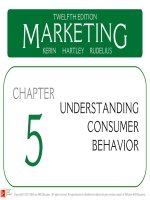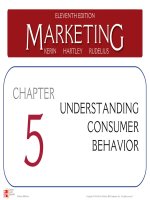Lecture Marketing (12/e): Chapter 8 – Kerin, Hartley, Rudelius
Bạn đang xem bản rút gọn của tài liệu. Xem và tải ngay bản đầy đủ của tài liệu tại đây (4.99 MB, 68 trang )
Copyright © 2015 McGrawHill Education. All rights reserved. No reproduction or distribution without the prior written consent of McGrawHill Education.
LEARNING OBJECTIVES (LO)
AFTER READING CHAPTER 8, YOU SHOULD BE ABLE TO:
LO 8-1
Identify the reason for conducting
marketing research.
LO 8-2
Describe the five-step marketing
research approach that leads to
marketing actions.
LO 8-3
Explain how marketing uses secondary
and primary data.
82
LEARNING OBJECTIVES (LO)
AFTER READING CHAPTER 8, YOU SHOULD BE ABLE TO:
LO 8-4
Discuss the uses of observations,
questionnaires, panels, experiments,
and newer data collection methods.
LO 8-5
Explain how information technology
and data mining lead to marketing
actions.
LO 8-6
Describe three approaches to
developing a company’s sales forecast.
83
REDUCING THE RISK OF A MOVIE’S FAILURE WITH
TEST SCREENINGS AND TRACKING STUDIES
What’s in a
Movie Name?
The Risks of Today’s
(and Tomorrow’s)
Blockbuster Movies
• Conduct Test
Screenings
• Use Tracking
Studies
84
FIGURE 8-A Marketing research questions
asked in test screenings of movies that lead to
specific actions
85
REDUCING THE RISK OF A MOVIE’S FAILURE WITH
TEST SCREENINGS AND TRACKING STUDIES
Converting
Marketing Research
Results into Actions
86
LO 8-1
THE ROLE OF MARKETING RESEARCH
What is Marketing Research?
The Challenges in Doing
Good Marketing Research
Five-Step Marketing Research Approach
• Decision
• Decision Making
87
FIGURE 8-1 Five-step marketing research
approach leading to marketing actions
88
LO 8-2
STEP 1: DEFINE THE PROBLEM
SET THE RESEARCH OBJECTIVES
Be Specific, Measurable,
and Achievable
Have a Clear
Research Purpose
Must Lead to
Marketing Actions
89
LO 8-2
STEP 1: DEFINE THE PROBLEM
SET THE RESEARCH OBJECTIVES
Exploratory Research
Descriptive Research
Causal Research
810
LO 8-2
STEP 1: DEFINE THE PROBLEM
SET THE RESEARCH OBJECTIVES
Measures of Success
Measure of Success: Playtime
• Children Spent More Time
Playing with Old Design
• Children Spent More Time
Playing with New Design
Possible Marketing Actions
• Continue with Old Design;
Don’t Introduce New Design
• Introduce New Design;
Drop Old Design
811
LO 8-2
STEP 2: DEVELOP THE RESEARCH PLAN
SPECIFY CONSTRAINTS
Constraints
Identify Data Needed
for Marketing Actions
812
LO 8-2
STEP 2: DEVELOP THE RESEARCH PLAN
DETERMINE HOW TO COLLECT DATA
Concepts
• New-Product Concept
Methods
• Sampling
• Statistical Inference
813
LO 8-3
STEP 3: COLLECT RELEVANT
INFORMATION/DATA
Data
Secondary Data
Primary Data
814
FIGURE 8-2 Types of marketing information
815
LO 8-3
STEP 3: COLLECT RELEVANT DATA
SECONDARY DATA
Internal
• Marketing Input Data
• Marketing Outcome Data
816
LO 8-3
STEP 3: COLLECT RELEVANT DATA
SECONDARY DATA
External
• Census Bureau
U. S.
2010
Census
American
Community
Survey
U. S. 2012 Economic Census
817
LO 8-3
STEP 3: COLLECT RELEVANT DATA
SECONDARY DATA
External
• Syndicated Panel
Nielsen TV Ratings
J.D. Power Surveys
IRI InfoScan
818
LO 8-3
STEP 3: COLLECT RELEVANT DATA
SECONDARY DATA
External
• Trade Associations
• Universities
• Business Periodicals
819
MARKETING INSITE
LO 8-3
Online Databases & Internet Resources
Statistical &
Financial Data
Wall Street
Journal
CNBC
Investors
Business
Daily
Fox
Business
News
Census
Bureau
Portals &
Search
Engines
USA.gov
820
LO 8-3
STEP 3: COLLECT RELEVANT DATA
SECONDARY DATA
Advantages
• Time Savings
• Inexpensive
Disadvantages
• Out of Date
• Definitions/Categories Not Right
• Not Specific Enough
821
LO 8-4
STEP 3: COLLECT RELEVANT DATA
PRIMARY DATA—WATCHING PEOPLE
Observational Data
Mechanical Methods
• Nielsen’s People Meter
• Nielsen’s TV Ratings
822
FIGURE 8-3 Nielsen Broadcast Ranking Report
for network TV primetime households for the
week ending May 19, 2013
823
LO 8-4
STEP 3: COLLECT RELEVANT DATA
PRIMARY DATA—WATCHING PEOPLE
Personal Methods
• Mystery Shopper
• Videotaping
• Ethnographic Research
Neuromarketing Methods
824
LO 8-4
STEP 3: COLLECT RELEVANT DATA
PRIMARY DATA—ASKING PEOPLE
Questionnaire Data
Idea Generation Methods
• Individual Interviews
• Depth Interviews
825









